 |
|
Jump to the summary list |
|
||||||||
It all began with a Hungarian playing a Romanian... |
||||
“Listen to them… children of the night… what music they make…” |
 |
Dracula*** (1931)
Significant performances: Bela Lugosi, Dwight Frye, Edward Van Sloan | 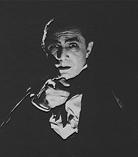 |
|
|
|
And so, enter heavyweight number two… |
||||
“It's alive… alive!” |
 |
Frankenstein**** (1931) |
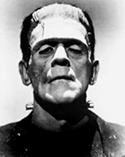 |
|
|
|
|
We break from the walking dead for a moment to introduce a marvellous curiosity. Technically nothing supernatural happens, but it deserves a place simply because you'll never see another film quite like it - |
“No beds! They can't 'ave beds!” |
 |
The Old Dark House**** (1932) |
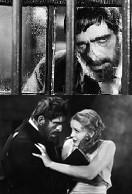 |
|
|
An elderly Egyptian gentleman now makes his first appearance, and LH pays further tribute to the actor tasked with bringing him (back) to life: |
||||
|
"I loved you once, but now you belong with the dead." |
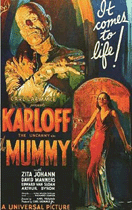 |
The Mummy** (1932) |
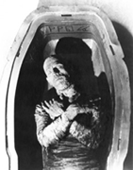 |
|
|
|
|
The British are dominating the genre now, as another takes centre stage for Mr Whale’s third masterpiece: |
||||
"The whole world's my hiding place!" |
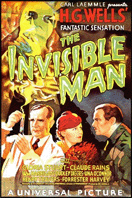 |
The Invisible Man**** (1933) |
 |
|
|
Bela Lugosi and Boris Karloff begin their onscreen rivalry with an unusual tale: |
||||
"I don't know, it all sounds like a lot of superstitious baloney to me." |
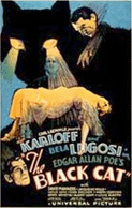 |
The Black Cat* (1934) |
 |
One old favourite now reaches its zenith, with the last of James Whale's contributions, as we drink a toast… |
||||
"…to a new world of Gods and Monsters!" |
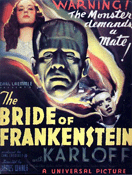 |
The Bride of Frankenstein**** (1935) |
 |
|
|
|
|
|
|
We sidetrack for another oddity, sadly lacking any big names but with a lot to answer for: |
||||
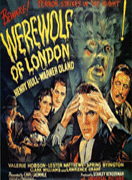 |
Werewolf of London* (1935)
|
Those two old warhorses Karloff and Lugosi are at it again: |
||||
"Your monstrous ugliness breeds monstrous hatred." |
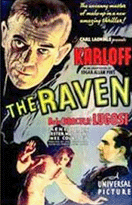 |
The Raven* (1935)
|
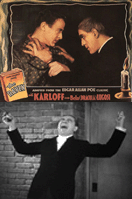 |
…and again, in another strange story which is not actually part of the Invisible Man series - |
||||
 |
The Invisible Ray* (1935)
|
The long wait for a sequel to Dracula finally ended, but Bela Lugosi's absence was a surprise - |
||||
"She was beautiful when she died... a hundred years ago." |
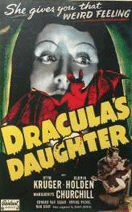 |
Dracula’s Daughter** (1936)
|
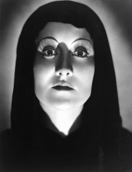 |
|
|
The continuation of the Frankenstein series is here explained - |
||||
|
“He... he... does things for me." |
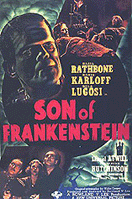 |
Son of Frankenstein*** (1939) |
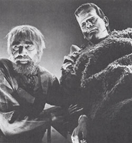 |
|
|
|
|
|
|
Vincent Price now takes on the role of the man who wasn't there: |
||||
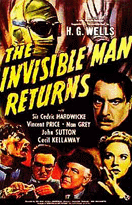 |
The Invisible Man Returns (1940)
|
The studio was once again pretty tardy in extending a series, with the Mummy at last returning, this time with Tom Tyler beneath the wrapping. |
||||
|
“Neither time nor death can touch us…” |
 |
The Mummy’s Hand** (1940) |
 |
|
|
The genre is nearly into its second decade now, with quality in short supply, as the invisible 'man' series illustrates. |
||||
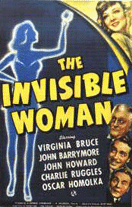 |
The Invisible Woman (demoted from *, in the 7th Edition) (1940) |
But a new franchise was about to get underway - |
||||
“Even the man who is pure in heart, |
And says his prayers by night, |
May become a wolf when the wolf bane blooms, |
And the moon is pure and bright." |
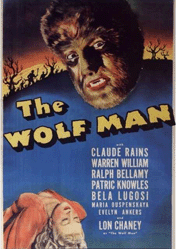 |
The Wolf Man* (demoted from **, in the 5th Edition) (1941) |
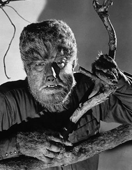 |
|
|
'The screen's master character actor' now steps into the Monster's hob-nailed boots |
||||
“Your father was Frankenstein, and your mother was the lightning!” |
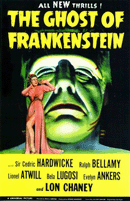 |
The Ghost of Frankenstein (1942)
|
|
|
A topical war-centred plot creeps into the Invisible Man series: |
||||
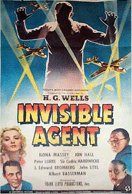 |
Invisible Agent* (1942)
|
We sidetrack for a moment, and take in a plotline that defies logic: |
||||
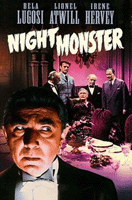 |
Night Monster (1942)
|
|
|
Chaney must have been determined to play every monster going, as he now dons the bandages. |
||||
"There is death in the night air - your work begins." |
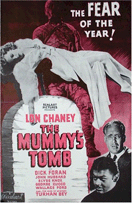 |
The Mummy’s Tomb (1942)
|
|
|
|
|
|
|
They must have had a problem when casting this one: I wonder if Chaney wanted both roles? Bela Lugosi ended up playing the Monster. |
||||
"It shouldn't be difficult to connect these wires again." |
 |
Frankenstein Meets the Wolf Man** (1943) |
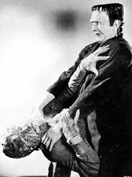 |
|
|
|
|
|||||||||||||||||||||||||||||||||||||||||||||||||||||||||||||||||||||||||||||||||||||||||||||||||||||||||||||||||||||||||||||||||||||||||||||||||||||||||||||||||||||||||||||||||||||||||||||||||||||||||||||||||||||||||||
|
|
‘Americans found it difficult enough to comprehend what was happening in the real Europe, while the imaginary one, natural habitat of the legendary monsters, seemed more and more remote. Quality of production no longer paid off; instead there was an insatiable public appetite for cheap, brisk entertainment on the comic-strip level, with plenty of mindless action and not too much regard for logic or probability.’ |
And thus the son of Dracula was born, with - yes, you guessed it - Mr. Chaney now donning the cape and fangs. |
||||
“You have what I want… what I need… what I must have!” |
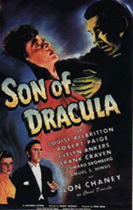 |
Son of Dracula* (1943) |
 |
|
|
|
|
It's all over for the Invisible Man, easily the weakest series in the genre, but the special effects are still impressing Halliwell - |
||||
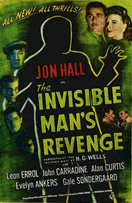 |
The Invisible Man’s Revenge (1944) |
|
|
Back to a contract-obligated Chaney in bandages: |
||||
"It does sound ridiculous, doesn't it?" |
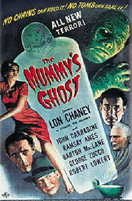 |
The Mummy’s Ghost (1944)
|
|
|
|
|
And so three monsters appear in one pic. John Carradine's Dracula gets killed off early before the story shifts emphasis - |
||||
"I'm going to give that brain of yours a new home." |
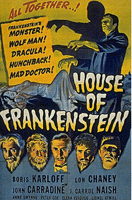 |
House of Frankenstein* (1944) |
 |
|
|
|
|
Our Egyptian friend finally staggers off the screen. |
||||
"Sometimes I feel as though it's all part of a strange dream." |
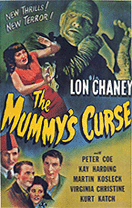 |
The Mummy’s Curse (1944)
|
|
|
|
|
|
|
It's all coming to a rather sad end, but these undead chaps won't give up lightly - |
||||
“The spark of life is still there, waiting to be revived... ” |
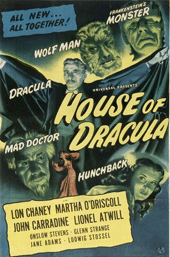 |
House of Dracula* (1945) |
 |
|
|
Since the genre had become something of a joke by now anyway, there was only one direction to go in: |
||||
"Every night when the moon is full I turn into a wolf." |
"You and fifty million other guys!" |
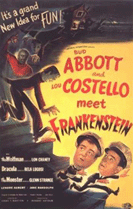 |
Abbott and Costello Meet Frankenstein** (1948) |
 |
Abbott and Costello Meet the Invisible Man* (1951) |
 |
Abbott and Costello Meet the Mummy* (1955)
|
|
|
|
|
And we may follow their Hammer adventures another time, but for now I'll let Edward Van Sloan close this particular chapter: |
||||
"When you go home tonight, and the lights have been turned out, and you are afraid to look behind the curtains, and you dread to see a face appear at the window, why, just pull yourself together and remember that, after all, there are such things..!" |
|
* * * *
* |
|
Biography |
Bibliography |
The Four Star Films |
A Four-Star History |
Brief History of the Guide |
|